The most exciting thing is to revisit and know when and how it all started. As the saying goes, "You've got to always go back in time if you want to move forward," so what better way than to talk to pioneers in the field of strabismus to know the past to forge into a great future in strabismology. Dr. Sowmya R spoke to the pioneers in the field to know the history of strabismology and share their experiences.

Dr. Pradeep Sharma MD, FAMS. is currently working as the Professor and Head of Section of Pediatric Ophthalmology, Strabismus, and Neuroophthalmology at Dr. RP Centre, AIIMS, New Delhi. He is also the Vice President of the Ophthalmic Research Association at RPC, AIIMS. After having finished his graduation ( 1979) and postgraduation (1982) at All India Institute of Medical Sciences, New Delhi, he did his Fellowship for Advanced training in strabismus in the USA at Jules Stein Eye Institute UCLA, Wills Eye Hospital Philadelphia and Richmond awarded by International Strabismological Association, 2001 He was the Visiting faculty in ORBIS, the Flying Eye Hospital in 2002. He has the credit of being the First Asian invited to deliver the Knapp Lecture by the American Association for Pediatric Ophthalmology and Strabismus, AAPOS Vancouver 2016, titled Pursuit of Stereopsis. He has many awards to his credit, Achievement Award by the American Academy of Ophthalmology, 2017, Col Rangachari Gold Medal for the Best Scientific Paper 1984, and Dr. Athavle Award 2002 All-India Ophthalmological Society, to name a few. Awarded Oration awards of State Ophthalmological Societies of Gujarat, West Bengal, Vidarbha, Delhi, Punjab, Bihar, Kerala, Poona-Maharashtra, Tamil Nadu. Also, Prof IS Roy Oration of KAO 2019, Prof HK Tewari Golden Apple 2019, Prof P Siva Reddy Oration of APOS, Kakinad, an AP, and Dr. Lall oration of HOS Sirsa, Haryana. He has International Membership in American Association for Pediatric Ophthalmology and Strabismus since 2004 and the International Strabismological Association since 2000. He is a Member of the Communications Committee International Pediatric Ophthalmology and Strabismus Council, IPOSC. He is the Chairman, Pediatric Ophthalmology & Strabismus, AIOS Collegium for FAICO. He is currently the President, SPOSI, Strabismus and Pediatric Ophthalmological Society of India. He has over 200 scientific articles in National and International journals or chapters in books to his credit. He has authored books namely, Strabismus Simplified and Essentials of Ophthalmology.
Dr. P Vijayalakshmi currently works as chief medical consultant of the Dept of Pediatric Ophthalmology and Adult Strabismus clinic and chief of Vision rehabilitation center at Aravind eye hospital, Madurai. After her ophthalmology residency, Dr. Vijayalakshmi joined Aravind Eye hospital as its first medical officer in 1976. She practiced general ophthalmology with community orientation before a formal fellowship training in pediatric ophthalmology and strabismusin 1982 at the University of Illinois in Chicago. She established the first of its kind, full-time, functioning pediatric ophthalmology and adult strabismus clinic in 1984 when the subspeciality was limited to strabismus alone. Started training fellows in the subspecialty from 1990 and till today 130 fellows including 18 international candidates have got trained. Numerous anesthetists, paramedical staff such as orthoptists, nurses, counselors, and community workers have been trained in pediatric ophthalmology. Her passion for the subject has involved many clinical/ epidemiological and research projects in pediatric ophthalmology. Population-based surveillance for congenital Rubella Syndrome was done in collaboration with ICMR and WHO; this study was pursued further and culminated in a landmark finding of isolating the region's circulating virus. She has facilitated various molecular genetics studies through AMRF, including those on congenital cataract, Globe anomalies, Aniridia, LCA, RP, and Oculocutaneous albinism to the extent of predicting the inheritance pattern through Amniocentesis. She has also collaborated with various prestigious institutes such as the Public Health Laboratory London,International Eye Foundation, USAID, ORBIS, ICO, and QEDJT. Unsurprisingly, she has 127 publications to her credit and has authored eight chapters for books apart from her widely read practical guides, onefor pediatricians and one forOrthoptists. She has recently focused on early intervention programs for visually impaired infants and toddlers, especially with CVI and autism. She holds pride in being recognized in the field as one of the core group under the pediatric Low vision rehabilitation committee of AAPOS. She is also the recipient of the Lifetime Achievement Award from SPOSI and Sadguru conclave at Chitrakoot. She has also been honored with the Joseph Gnanathickam, Captain Subramaniam, Eshwar Chandra H and Professor Sundareswaren's oration awards, TACO oration award, Dr. Kalidas Bhattachrya Memorial Award. Dr. David S Taylor has mentioned her as distinguished for "Worldwide teaching and training and research from India" one amongst the pioneers in pediatric ophthalmology worldwide in his chapter on the history of pediatric ophthalmology and strabismus in the 5th edition of Taylor and Hoyt's Pediatric Ophthalmology and Strabismus book
Dr. T S Surendran is currently working as the Director of the Department of Pediatric Ophthalmology and Strabismus Vice-chairman man Sankara Nethralaya, Chena i. He is also the Director of SN – ORBIS Pediatric Ophthalmology Learning and Training Centre. Having completed his graduation and postgraduation from Madras in 1979, he got an M.Phil from BITS, Pilani (1994) and has also completed FRCSEd. Being the founder member of the Strabismological Society of Indi, he held President of the society. He was the Assistant Medical Director of Sankara Nethralaya from March 1990 to February 1998 and became its Medical Director from March 1998 to September 2003. He has received many awards like Youth Excellence Award forthe year 1985, Col. Rangachari Awardfor the paper titled 'Paediatric Portable Keratometer,' at the AIOC at Ahmedabad 1990, "For the Sake of Honour Award" by The otClubclub of Madras Southwest for the year 2007, "Dr. Joseph Gnanadhickam Gold Medal Oration Award" for the year 2007 by Dr. Joseph Gnanadhickam Memorial Committee, Trichy for the outstanding contribution to the field of Ophthalmology awarded at Erode TNOA '07 to name a few. He has also received the "Best Doctor" Award for the year 2011 by Dr. M.G.R Medical University, Chennai for his exemplary contribution in the field of Medical Education & Healthcare Services and received Prestigious TNO, A Dr. S.S. Badrinath Medal of honor,r in 2015, in recognition for the outstanding contribution to the field of Ophthalmology at TNOA ConferenceMadurai. He has been awarded the "Lifetime Achievement Award" for the year 2014 by Strabismus and Pediatric Ophthalmological Society of India. He has performed nearly 25,000 strabismus surgeries and procedures, mostly in children. He has trained many fellows in the field of strabismus and has many publications to his credit.
eOphtha: Was strabismus recognized as a specialty when you started? Who practiced strabismus then?
Dr. Pradeep Sharma: In the early 80s, ophthalmology itself was relatively nascent, other specialties other than cataract had not developed, Neo-cornea, refractive surgery, and vitreoretinal were in their embryonic forms, so strabismus was the only specialty, so to say, and that was considered as a specialty of the more "thinking kind" as it was more mathematical and difficult for most. I remember few understood it, like Dr. Santokh Singh of Bhopal, Dr. Ishwar Chandra of Nagpur, Dr. MM Joshi of Hubli, and my mentor Prof Prem Prakash, and were therefore widely awed and respected. MajoritThe majority of general ophthalmologists are doing cataracts. Interestingly Strabismological Society of India was the first Speciality Association of Ophthalmology to be founded; by Prof Prem Prakash with Dr. Vijaylakshmi from Madurai, Dr. TS Surendran from Madras (Chennai), Prof Hanumantha Reddy from Hyderabad, Dr. BS Goel from Aligarh., Dr. Narang from Ahmedabad. Then I was a young senior resident,t having done my thesis under Prof. Prem Prakash and won the Col Rangachari award for best paper at AIOS(1984) as the youngest founder member. the first meeting in 1985 was held in New Delhi (Photograph 1)

Dr. P Vijayalakshmi: Yes. Strabismus was recognized as a specialty as early as 1960, well before the time I started practicing around 1980. General Ophthalmologists, who had developed some interest in the subject, practiced the subspecialty mostly through self-learning. The generous back up they had were well-trained orthoptists who took care of most of the patients except those who needed surgery, which were then done by the ophthalmologist.
Dr. T S Surendran: Squint surgeries started only in 80"s in India though a couple of surgeons were doing not full time. It was not a famous specialty, and I was one among the few doing full time on strabismus as General Ophthalmologists were doing the occasional squint. Yes --initially, strabismus was practiced by only a dozen surgeons in our country with Prof Prem Prakash at AIIMS at the helm. The First Strabismological society of India was formed in 1982 with six members, and I was one of the founder members; and this made a difference as more and more people were taking this specialty, which got converted to Paediatric ophthalmology in the late 90 "s and slowly to the present SPOSI.
eOphtha: What drew you to pursue this specialty then? Your role models?
Dr. Pradeep Sharma: Having done my MBBS from AIIMS, I joined MD Ophthalmology in Jan 1980 and was given a thesis topic on electrooculography (EOG) in strabismus. It interested me a lot, and I liked the subject as it had more to understand than to memorize by rote, as in other parts of ophthalmology. My research was also unique as per those times. Finally, having done my senior residency under Prof. Madan Mohan, an anterior segment stalwart, I was entrusted with strabismus when I joined as a faculty in 1987. And then having Prof. Prakash as my Senior, it was a pleasure in spreading awareness of strabismus around the country. Realizing the students' difficulty understanding, I thought of writing a simplified book on strabismus and was initially ridiculed for the title: "Strabismus Simplified" as an oxymoron! It launched in 1999 in Kochi AIOS; it was soon appreciated by the residents, fellows, and faculty worldwide and made the subject easy to many.
Apart from my mentors Prof Prem Prakash and Prof Madan Mohan (a surgeon par excellence), I got a chance to work under the great strabismologists in the US: Drs Isenberg, Rosenbaum, Demer, Reinecke, Calhoun, Nelson, and McNeer, during my six month ISA fellowship in UCLA, Los Angeles, Wills Eye, Philadelphia and Richmond, VA in 2001. (Photograph with Dr. Rosenbaum in his chamber) I also learned from the writings of Drs Jampolsky, von Noorden, Helveston, Wright, and Kushner.
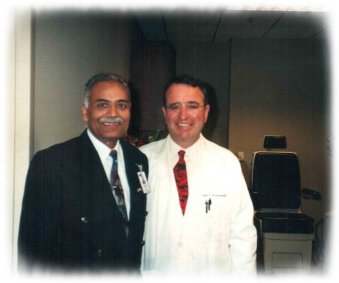
Dr. P Vijayalakshmi: I joined Aravind eye hospital as it's first Junior Ophthalmologist in the year 1976 and started with the general ophthalmology practice. As the institute grew, the demands for specialty services arose. As there were existing specialists for retina and neuro-ophthalmology, I was asked to pursue strabismology and general ophthalmology practice. So I entered the path of strabismology more out of need than out of choice. But I soon realized that I enjoyed this specialty, and it became more of a passion. Since there was no one to mentor me in the early days, a German strabismologist was invited in 1979 to spend three months with us and train me in the field.
To refine my skills further, I was sent to the University of Illinois for a six-month fellowship in 1982. This is where I met a senior colleague Dr. Marilyn Miller and thus began an excellent relationship. She has been my role model and my mentor at all stages of my career. ( Photograph 3) She is also responsible for globally pushing for the integration of Paediatric ophthalmology practice and strabismus to make it into a comprehensive one. In 1984, during one of Dr. Miller's visits to India, we renamed the squint clinic at our institute as the department of Paediatric Ophthalmology and Adult Strabismus clinic, and children were no longer seen in the general clinics; but recieved more comprehensive care with specially trained staff in this specially designated department. ( Photograph 4) With her encouragement, I started training fellows in the year 1990. We initially trained 1 or 2 fellows per year and have now grown to 8 to 10 per year, with more young ophthalmologists showing interest in this specialty.
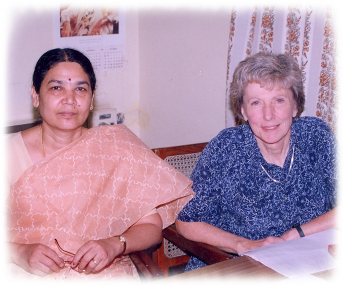
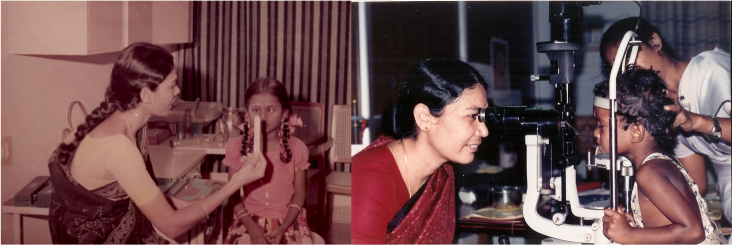
Dr. T S Surendran: I joined Sankara Nethralaya in the Vitreoretinal dept and switched over to strabismus. There were too many consultants in Vitreoretina on the suggestion of Dr. Badrinath. My Role Models were Prof. Prem Prakash, Drs Marshal Parks, Jampolsky, Richard Robb, Alan Scott, Craig Hyot, to name a few.
eOphtha: How was the scenario for strabismus as a subspeciality when you started? How has strabismus subspeciality emerged in India?
Dr. Pradeep Sharma: The Strabismus Society then was very small. With the efforts of the great strabismologists I named earlier, it took off well with initially, a conference being held, once in two years. But several regional updates in different parts of the country were organized by Dr. P Vijaylakshmi at Aravind, Madurai, Dr. Reddy at Hyderabad, Dr Narang Ahmedabad, Dr. TSS, Chennai, Dr. Kanwar Mohan, Chandigarh, and gradually more and more people gave the momentum to the movement. (Photograph 5)
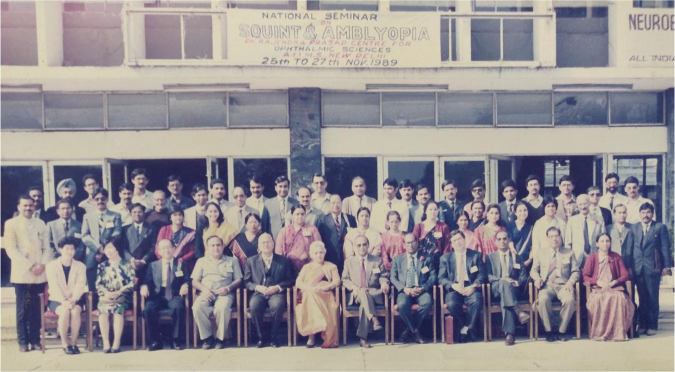
The recognition of India on the world stage is now seen with Dr. Vijayalakshmi writing a piece on Indian Strabismus in JAAPOS, 2002, myself being honored by the Knapp Memorial award at Vancouver in 2016 (first to any Asian, Photograph 6) and now Dr. Ramesh Kekunnaya playing an active role in WSPOS (World society of pediatric ophthalmology and strabismus). Now the discussion groups on social media are also very active. I do my little bit on YouTube (click to open), posting the surgical videos, and my music which goes along with it as "Strab is Music"!
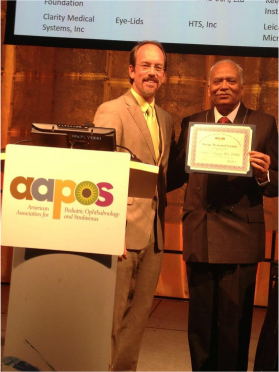
Dr. P Vijayalaksmi: Only a few strabismologists were practicing the specialty at that time. I understand that only the post-graduate teaching institutes had this specialty in the early days. As most of the time, the ophthalmologist were busy with other activities, Orthoptists gained more experience and had a stronger hold of running the department. Ophthalmologists were called in only when the patient required surgical correction.
I believe inadequate exposure to this field was why residents did not develop an interest in strabismology. However, strabismologists like Dr. Prem Prakash, Professor of strabismology at AIIMS, who was well versed in the subject, had a great interest in developing the subspeciality. He started an association by the name Strabismological Society of India in 1983, which met once in 2 years conducting CMEs and encouraging free papers from residents and junior strabismologists. This impacted all of us, and we started meeting once a year and later with mid-term meetings.
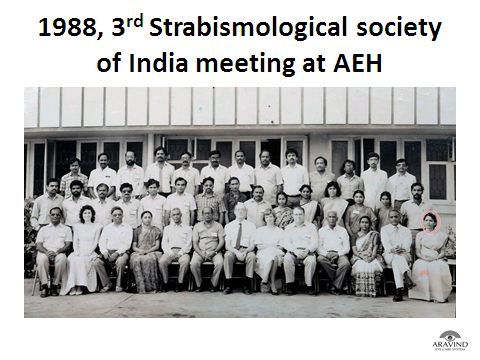
One of the first international meetings on pediatric ophthalmology and strabismus was held at Aravind Eye Hospital in 1986. (Photograph 8)
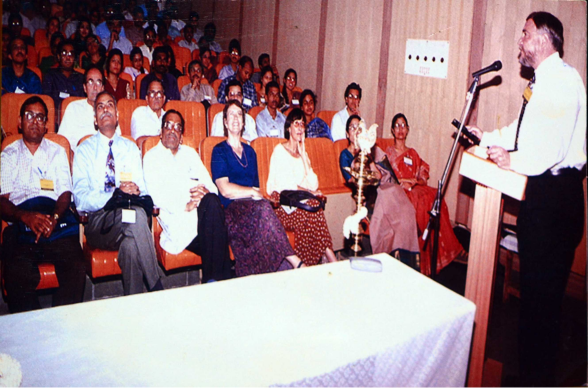
Dr. T S Surendran: Back then, only a few general ophthalmologists practiced strabismus. The strabismological society of India started at Calcutta with six members, including me as the founder member led by Prof. Prem Prakash emerged and merged into Paediatric ophthalmology. Society conducted CME's and conferences and drew more ophthalmologists towards this subspeciality.
eOphtha: What were the first strabismus surgeries you performed? Are there any strabismus surgeries you performed earlier and abandoned later with time?
Dr. Pradeep Sharma: Recessions and Resections were initially done by Swan's incision(para-limbal) by my seniors, a little later by limbal. Most people followed only that in India. I picked up the fornix incision on my fellowship and promoted it on my return in 2001. Inferior Oblique recessions by Fink's method or Myectomies was practiced by my seniors. I picked up the anteropositioning (E&N) from books and popularized the modified version (1994).
Similarly, Superior Obliques were generally dreaded, but we gradually got confidence and promoted controlled procedures. Adjustable surgery was not popular even though described by Jampolsky quite early. My fellowship training made me more adept at that, and I suggest it is a great boon in trying situations.
Amongst the obsolete surgery that I saw my seniors doing and now I would not do are: SO transposition in Third Nerve palsy, MR recessions as part of differential recession in Exo DRS, Free tenotomies of SO. We have more controlled and better options to "tame the Obliques!"
Dr. P Vijayalakshmi: My first surgeries were the recession and resection surgeries on adults' horizontal muscles. We have not abandoned any of the surgeries that I began with, but there have been various modifications with technology, instrumentation, surgical techniques, and sutures. We no longer use the catgut or polyester sutures that we had used early on. We used to use a muscle clamp, which is no longer used. The most significant change would probably be the shift to the operating microscope versus the loupe
Dr. T S Surendran: First surgeries were done as Recession and Resections with weakening procedures of inferior obliques and superior obliques with superior oblique tucks and occasionally Knapps procedure.Tuck of superior oblique was abandoned
eOphtha: When you compare past and present-day – what are the changes you see in patients seeking consultation to acceptance of surgery? What were the challenges in convincing patients /parents for strabismus surgery then and now?
Dr. Pradeep Sharma: There is a significant change in the patients' perception and even of the ophthalmologists, and that is the timing of surgery. Early surgery was feared and not thought of as beneficial. Therefore it was considered more of Cosmetic surgery, and the notion is still there in a large section of our general population, creating difficulties in claims from Insurance companies, for which we got a clarification from PM and should facilitate this. We all have been doing and still need to spread the awareness of "Eye muscle surgery" as a "restorative surgery" as it restores binocular vision and stereopsis. And should be done early in childhood when binocular vision is developing. The other fear of the patients about the surgery being "traumatic" or "bloody" also needs to be repudiated. The confidence built up by creating awareness of strabismus surgery is as clean as Cataract or Corneal surgery.
The Strabismus practitioners also need to owe it to the patient to give a detailed record of the preoperative motility status. The surgery is performed so that if any surgery is required in the future, the subsequent surgeon has the status.
Dr. P Vijayalakshmi: Though the acceptance rate for strabismus surgery is better now, the challenges remain the same. There were times people never understood binocularity, and strabismus surgery was thought of as cosmetic surgery only. Bilateral surgeries were harder to make them accept. Now that the present-day parent's literacy is better, acceptance of strabismus surgery to maintain binocularity is well understood. The socio-economic background remains the main roadblock for acceptance of surgery.
Dr. T S Surendran: Presently, the acceptance rate is very high with parents, and in those days, strabismus surgeries were considered only as cosmetic surgeries. Challenges were only convincing the parents to accept general anesthesia and a little discussion on the outcome of the surgery
eOphtha: What are the revolutionary strabismus surgeries you have seen in your career? How do you foresee the strabismus branch emerge in the future?
Dr. Pradeep Sharma: The Strabismus surgery has come gradually in the pediatric ophthalmology domain, where it rightly belongs majorly except for the acquired problems. The importance of binocular vision and stereopsis demands this and not just strabismus, but also the other detriments to the development of binocular vision needs to be addressed by the present pediatric ophthalmologist. With more varieties of eye muscle surgery, like transposition procedures and more controlled oblique muscle surgeries, as also reinforced plication or combined resection-recession surgery, the challenges we face are getting better resolved.
I feel contented to see the rejuvenated interest of the present generation in Pediatric Ophthalmology and Strabismus. There are so many young enthusiasts of this specialty in different parts of our country now, and there are many active groups on social media. The SPOSI and AAPOS and WSPOS have active members from India. This will ensure that the "S4Squint" now stands for the "S44S: Strabismus, Sight, Stereopsis, and Smiles for all".
Best wishes to all the lovers of Pediatric Ophthalmology and Strabismus. Thank you for this opportunity. Strabismologically yours
Dr. P Vijayalaksmi: Surgeries for paralytic squint including muscle fixation surgery, transposition surgeries with vessel sparing. There have also been various developments in surgical procedures for Duane's, Brown's, and in orbital asymmetries, To name a few more. Retrieving of lost muscle and transposition of IO for the lost IR muscle, tendon expanders, transplanting the power, bilateral surgeries for nystagmus associated with strabismus, Botox injections, etc. I see now more and more innovations to address the subtle problems of convergence, accommodation, fusion anomalies, etc. I feel these problems will be on the rise, and we need to innovate therapies that could be undertaken at home with digital monitoring. These developments will make an impact in the future.
Dr. T S Surendran: There is no revolutionarysurgery at present done by me though technically there were updates like adjustable sutures, Botox injectionsfor strabismus, hang back and hemi hang back, Nishida procedure, Modified Andersons procedure in nystagmus, anchoring medial rectus on to the periosteum in IIIrd nerve palsy and so on...
With the present population of our country, the number of squints to be operated will be enormous, and we need more strabismologists taking up this specialty in the near future. Virtual consultations, virtual meetings, conferences, and live procedures are expected to be more in the future
5.jpg)